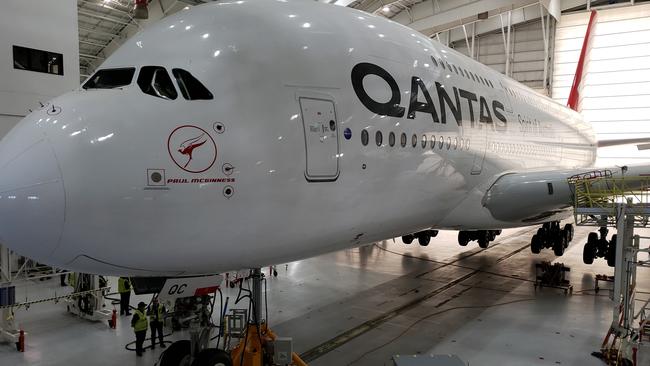Rattlesnakes living in Qantas A380s stored in Mojave desert
For Qantas engineers working in the Mojave desert, every day is now ‘whacking day’.

Qantas’s fleet of A380s parked in California’s desert are proving popular with local wildlife, with “snakes on a plane” very much a reality for the engineers tasked with maintaining them.
Highly venomous Mojave rattlesnakes and scorpions have been setting up camp around the wheel wells and tyres of the mothballed superjumbos, now expected to stay put for another two years.
As a result engineers have brought in a new tool to aid in their regular aircraft inspections, known as “wheel whackers”.
Qantas manager for engineering in Los Angeles Tim Heywood said the repurposed broom handles were now part of each engineering kit at Victorville, to scare off the feisty rattlers from the A380s warm rubber tyres and brake system.
“The first thing we do before we unwrap and start any ground inspections of the landing gear in particular is to walk around the aircraft stomping our feet and tapping the wheels with a wheel whacker to wake up and scare off the snakes. That’s about making sure no harm comes to our engineers or the snakes,” said Mr Heywood.
“Only then do we carefully approach each wheel and unwrap them before performing our pressure checks and visual inspections.”

Close encounters of the slithering kind were not uncommon, but the “wheel whacker” generally did its job and sent the snake on its way, Mr Heywood said.
“It’s a unique part of looking after these aircraft while they’re in storage and it’s another sign of how strange the past year has been,” he said.
“These A380s would rarely spend more than a day on the ground when they were in service.”
Any snake that chose to ignore the wheel whacker would have had an even bigger shock this week, when one of the A380s took to the skies for the first time in 290 days.
Registered VH-OQC, the aircraft flew from Victorville to Los Angeles to undergo a gear swing procedure at Qantas’ LAX hangar.

“Aircraft like these are highly technical and you can’t just land it at the storage facility, park it and walk away,” said Mr Heywood.
“It’s really important that even when in deep storage, the aircraft are maintained to the Qantas standard.”
Engineers’ work involved everything from covering the interior seats with plastic sheeting to applying protective film to the top of the rudder and on all of the cabin windows.
The wheels, tyres and landing gear legs were wrapped in protective film and all inlets and orifices on the fuselage are plugged to avoid insects, birds and even bats making themselves at home.
Mr Heywood said they were all keen to see the aircraft back in service, and were “proud to keep them in top notch condition” until that time came.
“We can hang up our wheel whackers at that point,” he said.
Despite speculation Qantas would not return all 12 A380s to service, airline CEO Alan Joyce remained hopeful there would come a time when they were needed.
Previously used on services to London, Los Angeles and Dallas-Fort Worth, it’s expected the A380s will again fly those routes when demand for air travel returned to pre-Covid levels.




To join the conversation, please log in. Don't have an account? Register
Join the conversation, you are commenting as Logout